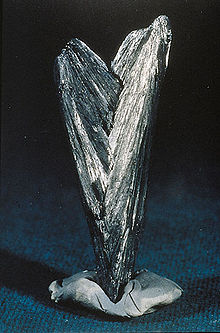- Manganite
-
- This article is about the mineral of formula MnO(OH), for other uses of the term manganite see Manganite (disambiguation)
Manganite 
Manganite, Ilfeld, Thuringia, Germany (size: 5.2×4.1×2.7 cm)General Category Oxide mineral Chemical formula MnO(OH) Strunz classification 04.FD.15 Dana classification 06.01.03.01 Crystal symmetry Monoclinic 2/m prismatic Unit cell a = 8.94 Å, b = 5.28 Å, c = 5.74 Å; β = 90°; Z = 8 Identification Color Dark steel-gray to black, reddish brown in transmitted light, gray-white with brownish tint, with blood-red internal reflections in reflected light Crystal habit Slender prismatic crystals, massive to fibrous Crystal system Monoclinic, pseudo-orthorhombic Twinning Contact and penetration twins on {011} Cleavage {010} perfect, {110} and {001} good Fracture Uneven Tenacity Brittle Mohs scale hardness 4 Luster Sub-metallic Streak Reddish brown to nearly black Diaphaneity Opaque, transparent on thin edges Specific gravity 4.29–4.34 Optical properties Biaxial (+) Refractive index nα = 2.250(2)
nβ = 2.250(2)
nγ = 2.530(2)Birefringence δ = 0.280, Bireflectance: distinct in grays Pleochroism Faint 2V angle Small Dispersion Very strong References [1][2][3][4][5] Manganite is a mineral. Its composition is manganese oxide-hydroxide, MnO(OH), crystallizing in the monoclinic system (pseudo-orthorhombic).[1] Crystals of manganite are prismatic and deeply striated parallel to their length; they are often grouped together in bundles. The color is dark steel-grey to iron-black, and the luster brilliant and submetallic. The streak is dark reddish-brown. The hardness is 4, and the specific gravity is 4.3. There is a perfect cleavage parallel to the brachypinacoid, and less-perfect cleavage parallel to the prism faces. Twinned crystals are not infrequent.
The mineral contains 89.7% manganese sesquioxide; it dissolves in hydrochloric acid with evolution of chlorine.
Occurrence
Manganite occurs with other manganese oxides in deposits formed by circulating meteoric water in the weathering environment in clay deposits and laterites. It forms by low temperature hydrothermal action in veins in association with calcite, barite, and siderite. Often associated with pyrolusite, braunite, hausmannite and goethite.[1][4]
Manganite occurs in specimens exhibiting good crystal form at Ilfeld in the Harz Mountains of Germany[5], where the mineral occurs with calcite and barite in veins traversing porphyry. Crystals have also been found at Ilmenau in Thuringia, Neukirch near Sélestat in Alsace (newkirkite), Granam near Towie in Aberdeenshire, and in Upton Pyne near Exeter, UK and Negaunee, Michigan, United States, and in the Pilbarra of Western Australia. Good crystals have also been found at Atikokan, Ontario and Nova Scotia, Canada. As an ore of manganese it is much less abundant than pyrolusite or psilomelane.
Although described with various other names as early as 1772, the name manganite was first applied in a publication by W. Haidinger in 1827.[6]
References
- ^ a b c Handbook of Mineralogy
- ^ Mindat
- ^ Webmineral data
- ^ a b Klein, Cornelis and Cornelius S. Hurbut, Jr., Manual of Mineralogy, Wiley, 20th ed., 1985, p. 317 ISBN 0-471-80580-7
- ^ a b T. P. Moore, Famous Mineral Localities: Ilfeld, Harz Mountains, Thuringia, Germany, The Mineralogical Record, vol. 41, no. 6, 2010.
- ^ Palache, Charles, Harry Berman and Clifford Frondel, The System of Mineralogy V. 1, p. 646, Wiley, 7th ed., 1944
 This article incorporates text from a publication now in the public domain: Chisholm, Hugh, ed (1911). Encyclopædia Britannica (11th ed.). Cambridge University Press.
This article incorporates text from a publication now in the public domain: Chisholm, Hugh, ed (1911). Encyclopædia Britannica (11th ed.). Cambridge University Press.
Manganese minerals Borates Carbonates Oxides SimpleMixedBirnessite · Bixbyite · Ferrocolumbite · Ferrotantalite · Galaxite · Jacobsite · Manganotantalite · Psilomelane · Romanèchite · Tantalite · Todorokite · UmberPhosphates Childrenite · Graftonite · Lithiophilite · Natrophilite · Purpurite · Triplite · Triploidite · ZanazziiteSilicates Babingtonite · Bixbite · Braunite · Brownleeite · Calderite · Chloritoid · Eudialyte · Glaucochroite · Jeffersonite · Knebelite · Ottrelite · Piemontite · Pyroxferroite · Rhodonite · Spessartine · Sugilite · Tephroite · Zakharovite · ZircophylliteSulfides Other Axinite (borosilicate) · Geigerite (arsenate) · Manganese nodule (various) · Samsonite (Sulfosalt) · Zincobotryogen (sulfate)Categories:- Manganese minerals
- Hydroxide minerals
- Monoclinic minerals
Wikimedia Foundation. 2010.


